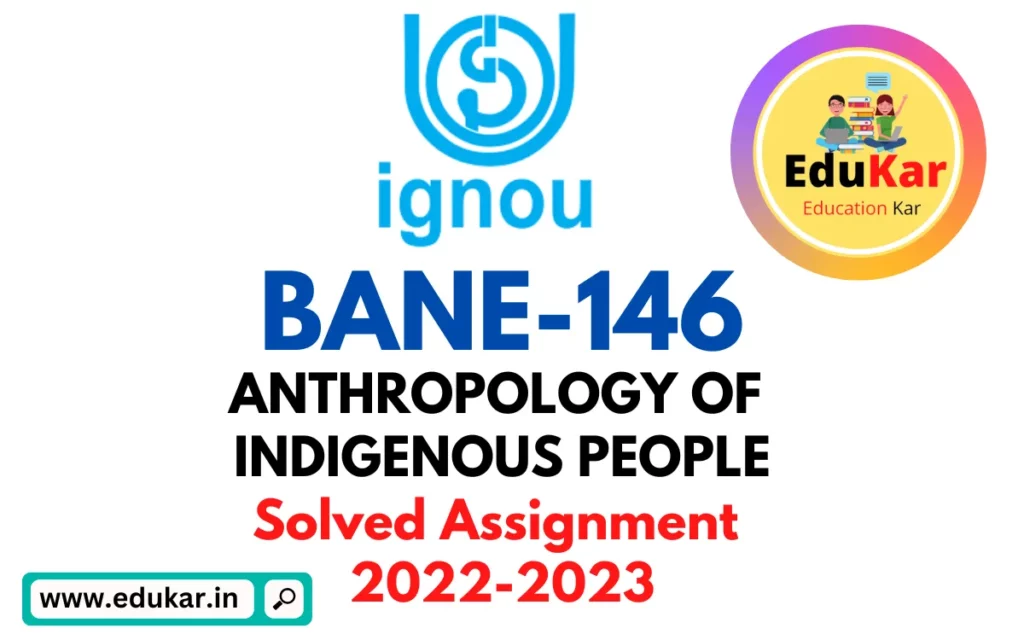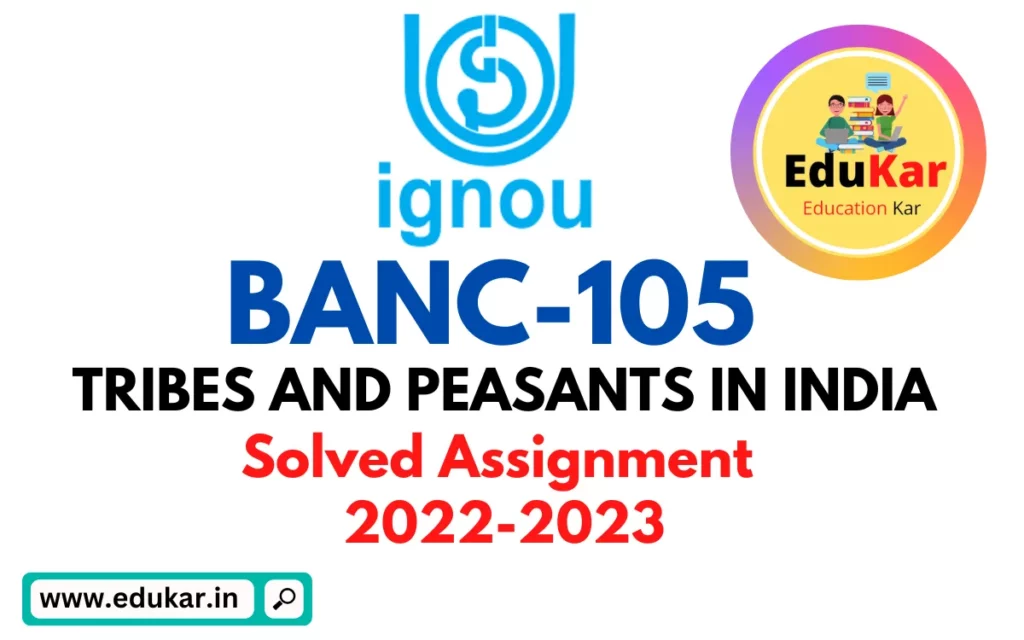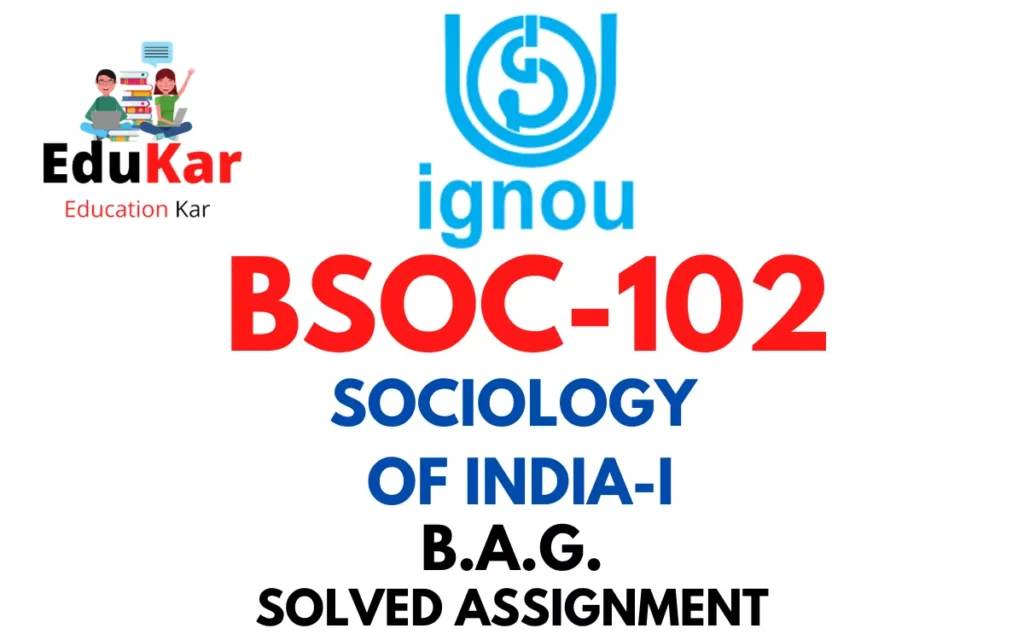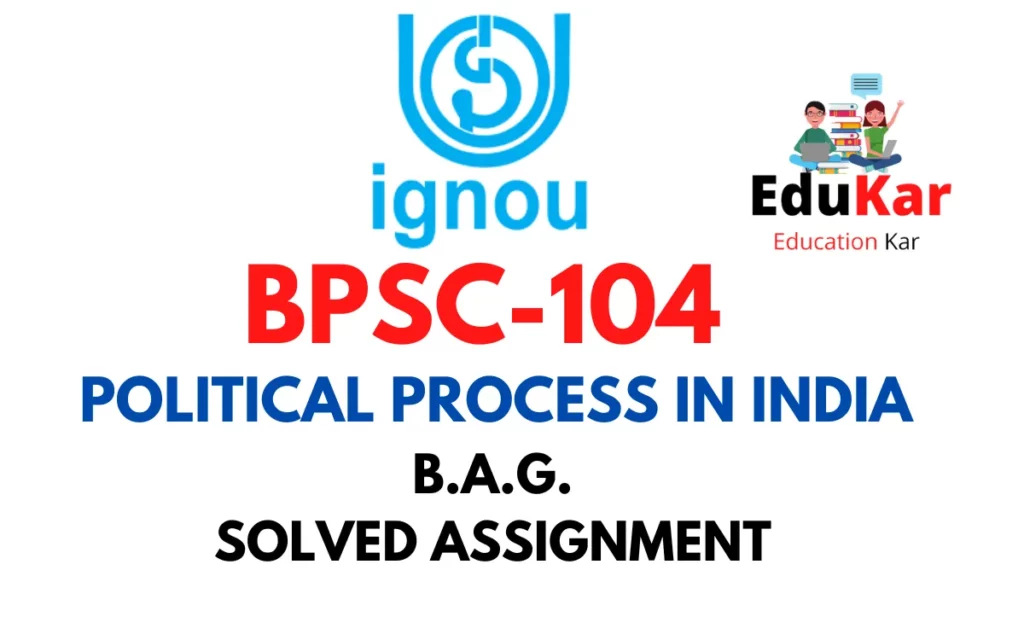Contents
- 1 Assignment – I
- 2 Answer the following in about 500 words each.
- 3 1. Define Indigenous people. Discuss the problem of identification of Tribes as Indigenous peoples.
- 4 2. Briefly examine how education play an important role in the social transformation of Indigenous peoples.
- 5 Assignment – II
- 6 Answer the following questions in about 250 words each.
- 7 3. Classification of the population of India by HH Risley.
- 8 4. Briefly comment on the Indigenous methods of Conservation of Land and Soil.
- 9 5. Write a note on Color Blindness.
- 10 Assignment – III
- 11 Answer the following questions in about 125 words each.
- 12 6. Particularly Vulnerable Tribal Groups (PVTGs).
- 13 7. Tribe-Caste continuum.
- 14 8. Sanskritization.
- 15 9. Indigenous Knowledge and water.
- 16 10. Little and Great Tradition.
- 17 11. ABO blood group system.

| Title | BANE-146: IGNOU BAG Solved Assignment 2022-2023 |
| University | IGNOU |
| Degree | Bachelor Degree Programme |
| Course Code | BANE-146 |
| Course Name | ANTHROPOLOGY OF INDIGENOUS PEOPLE |
| Programme Name | Bachelor of Arts (General) |
| Programme Code | BAG |
| Total Marks | 100 |
| Year | 2022-2023 |
| Language | English |
| Assignment Code | BANE 146/ASST/TMA/July 2022-January 2023 |
| Last Date for Submission of Assignment: | For June Examination: 31st April For December Examination: 30th September |

Assignment – I
Answer the following in about 500 words each.
1. Define Indigenous people. Discuss the problem of identification of Tribes as Indigenous peoples.
Ans: Indigenous peoples are those communities and groups who have lived in a particular region for generations and have a unique cultural, linguistic, and social identity. They are considered the first peoples of a land and have a deep spiritual and historical connection to their ancestral territories. Indigenous peoples are found all over the world, from the Americas to Africa, Asia, and Australia.
The term ‘indigenous’ refers to the long-standing presence of these communities in their lands, which predates the arrival of settlers and colonizers. Indigenous peoples have faced a long history of oppression, exploitation, and marginalization, often at the hands of colonial powers, and as a result, many Indigenous cultures and languages are in danger of being lost.
One of the major challenges in identifying Indigenous peoples is the issue of definition and criteria. In some cases, governments or other entities use a narrow definition that only recognizes certain groups as Indigenous, while others use a broader definition that includes a wider range of communities. This can result in disputes over who is considered Indigenous and who is not, and can lead to unequal treatment and recognition of different groups.
Another issue with the identification of Indigenous peoples is the problem of self-identification. Indigenous peoples have the right to self-identify as Indigenous and to be recognized as such by others. However, in some cases, Indigenous communities may not be recognized by governments or other entities as Indigenous, even though they consider themselves to be so.
The problem of identification is particularly pronounced in countries with a long history of colonization, where Indigenous communities have been subjected to a process of assimilation, where their cultural and linguistic identities have been suppressed. In these countries, Indigenous peoples may not have the legal recognition or protection they need to assert their rights, or to participate fully in the life of their societies.
Ans: Education plays a critical role in the social transformation of Indigenous peoples by providing them with the knowledge, skills, and confidence they need to assert their rights and to participate fully in the life of their societies. By providing Indigenous peoples with access to quality education, they are able to break free from the cycle of poverty and marginalization, and to gain a voice in shaping their own futures.
One of the key benefits of education for Indigenous peoples is that it provides them with a sense of cultural identity and pride. Through education, Indigenous peoples can learn about their own cultural traditions, history, and values, and can gain a deeper understanding of their place in the world. This knowledge is particularly important for Indigenous youth, who are often at risk of losing touch with their cultural roots, as they are exposed to new and often conflicting cultural influences.
In addition to promoting cultural identity, education also helps Indigenous peoples to develop the critical thinking skills they need to navigate the complexities of modern society. By gaining access to quality education, Indigenous peoples are able to challenge existing power structures and to demand greater respect and recognition of their rights. They are also able to become active and informed participants in the political and social life of their communities and countries.
Another important benefit of education for Indigenous peoples is that it provides them with the tools they need to improve their economic and social status. Education can help Indigenous peoples to gain access to better jobs and to improve their income levels, which in turn, can improve their quality of life. This is particularly important for Indigenous women and girls, who are often the most marginalized and excluded members of Indigenous communities.
However, despite the many benefits of education for Indigenous peoples, there are also many challenges that must be overcome in order to ensure that Indigenous peoples have access to quality education. One of the biggest challenges is the lack of resources, both financial and human, available to Indigenous communities. Many Indigenous communities are located in remote and isolated areas, where there are few resources available to support education.
Another challenge is the lack of cultural relevance in the education provided to Indigenous peoples. In many cases, education systems and curricula are designed without consideration for the needs and interests of Indigenous peoples, and as a result, Indigenous students are often disengaged and disinterested in their education.
Assignment – II
Answer the following questions in about 250 words each.
3. Classification of the population of India by HH Risley.
Ans: H.H. Risley was a British colonial administrator in India who is known for his work on the classification of India’s population. Risley was one of the key figures in the British colonial administration and was appointed as the census commissioner of India in 1891. He was tasked with conducting the census of India and classifying the population based on various socio-cultural and physical characteristics.
Risley’s classification of India’s population was based on the concept of race and he believed that race was a key factor in determining a person’s status in society. He classified India’s population into seven main racial groups: Aryans, Dravidians, Mongoloids, Austrics, Indo-European, Semites, and the mixed races. He also classified each of these groups into further sub-categories based on physical and cultural characteristics.
Risley’s classification was used as a basis for the British colonial administration’s policies towards India’s population. The British used his classification to justify their policies of divide and rule, which were aimed at maintaining their control over India. For example, the British used Risley’s classification to justify their discriminatory policies towards certain groups, such as the lower castes, who were considered to be of a lower racial stock.
Despite the fact that Risley’s classification was widely criticized for being unscientific and racist, it had a lasting impact on India’s society and continues to influence the way India’s population is perceived and treated. The legacy of Risley’s classification can still be seen in India today, where issues of caste and race continue to play a significant role in determining a person’s status and opportunities in society.
4. Briefly comment on the Indigenous methods of Conservation of Land and Soil.
Ans: Indigenous peoples have developed unique and effective methods of conserving land and soil, which have been passed down from generation to generation. These methods are based on a deep understanding of local ecosystems, and reflect the close relationship between Indigenous peoples and the land.
One of the key methods of conservation used by Indigenous peoples is sustainable agriculture. Indigenous peoples use a variety of traditional farming practices that promote soil conservation and fertility, such as crop rotation, intercropping, and the use of organic fertilizers. These practices help to maintain the health of the soil and to ensure that it can continue to support crop production in the long-term.
Another important method of conservation used by Indigenous peoples is the management of forests and other natural resources. Indigenous peoples often use traditional techniques, such as selective harvesting and controlled burning, to manage forests and to maintain their health and productivity. These techniques help to preserve the biodiversity of the forests and to ensure that they can continue to provide resources for future generations.
Indigenous peoples also use a variety of traditional practices to conserve water resources, such as the construction of terraces and the use of irrigation systems. These practices help to ensure the long-term productivity of agriculture, and to prevent soil degradation and erosion.
5. Write a note on Color Blindness.
Ans: Color blindness, also known as color vision deficiency, is a genetic condition that affects the way a person perceives color. People with color blindness are unable to see certain colors, or see them differently from people with normal color vision.
There are different types of color blindness, but the most common form is red-green color blindness, which affects the ability to distinguish between red and green hues. Other forms of color blindness can affect the perception of blue and yellow hues, or result in complete color blindness, where a person sees only shades of gray.
Color blindness is caused by genetic factors and is passed down from parents to their children. It is more common in men than in women, and affects about 8% of males and 0.5% of females of Northern European descent.
The impact of color blindness can vary depending on the severity of the condition, but it can affect a person’s ability to perform certain tasks, such as reading traffic lights or differentiating between fruits and vegetables. It can also impact a person’s social and emotional well-being, as they may feel excluded or frustrated by their inability to see certain colors.
However, with modern technology and assistive devices, people with color blindness can lead fulfilling lives. For example, special glasses or contact lenses can help to enhance color perception, and computer software can be used to adjust the color palette on electronic devices.
Assignment – III
Answer the following questions in about 125 words each.
6. Particularly Vulnerable Tribal Groups (PVTGs).
Ans: Particularly Vulnerable Tribal Groups (PVTGs) are a set of tribes in India that have been identified as facing severe social, economic and political disadvantages. These tribes are considered to be the most marginalized and vulnerable communities in India, with a lower level of development compared to other tribal groups.
The PVTGs are spread across several states in India and are characterized by a small population size, limited access to resources and education, and low levels of health and nutrition. They also face a range of cultural and linguistic challenges, as well as threats to their traditional livelihoods.
The Indian government has taken several measures to address the needs of PVTGs, including targeted development programs and policies aimed at improving their living standards, access to resources and education, and protection of their cultural heritage.
However, despite these efforts, the situation of PVTGs remains challenging, and there is a need for continued attention and support from government, civil society and the international community.
7. Tribe-Caste continuum.
Ans: The tribe-caste continuum refers to the complex relationship between tribal communities and caste communities in India, and the gradual process of assimilation that often leads to the loss of tribal identity and culture.
Tribal communities in India have traditionally been distinct from caste communities, with their own unique cultures, languages, and social structures. However, over time, as tribal communities have come into contact with caste communities and been exposed to the wider Indian society, many have adopted elements of caste-based social norms and practices.
This process of assimilation can result in the erosion of tribal identity and cultural practices, and the gradual absorption of tribal communities into the caste system. In some cases, this process can lead to the loss of traditional livelihoods, land rights, and cultural heritage, and the marginalization of tribal communities within the wider society.
It is important to recognize and understand the complex nature of the tribe-caste continuum, as it has significant implications for the rights and well-being of tribal communities in India. The recognition of tribal rights and the protection of tribal cultures and identities is an important step towards promoting social justice and equity in India.
8. Sanskritization.
Ans: Sanskritization is a sociological process by which lower-caste and tribal communities in India adopt the customs, beliefs, and practices of the higher-caste Hindu community in an attempt to improve their social status and gain acceptance in Hindu society.
This process often involves adopting Hindu religious rituals and practices, as well as taking on Hindu names, dress, and other cultural markers. The aim is to become more like the dominant Hindu community and gain recognition as part of the larger Hindu community.
Sanskritization has been a significant factor in the gradual assimilation of tribal and lower-caste communities into Hindu society. It has also led to the erosion of traditional tribal cultures and identities, as well as the marginalization of these communities within the wider society.
However, Sanskritization is not always a straightforward process and can also lead to conflicts within communities, as well as resistance from members who do not wish to abandon their traditional cultures and identities.
Overall, Sanskritization is an important process to understand in the context of Indian society, as it sheds light on the complex relationships between different cultural and social groups in India, and the ways in which these relationships have changed over time.
9. Indigenous Knowledge and water.
Ans:
Indigenous knowledge refers to the traditional ecological and cultural knowledge developed by indigenous communities over generations of living in close relationship with their natural environment. This knowledge includes a deep understanding of the local environment, including the water cycle, the use of water for various purposes, and the management of water resources.
Indigenous communities often have a rich tradition of knowledge about the water cycle and the interdependence of water and the environment, and they often use this knowledge to manage their water resources in sustainable and equitable ways. This knowledge is rooted in the community’s culture and is passed down from generation to generation through oral tradition, storytelling, and other cultural practices.
However, despite the significant contributions of indigenous knowledge to sustainable water management, it is often undervalued and marginalized by dominant Western scientific and technical approaches to water management. In many cases, indigenous knowledge is threatened by development projects, such as dam construction, that destroy traditional water sources and disrupt water cycles, as well as by the loss of cultural traditions and practices.
Therefore, it is important to recognize and value indigenous knowledge in water management and to work towards incorporating this knowledge into more holistic and sustainable approaches to water management, so that the unique perspectives and insights of indigenous communities can be incorporated and preserved for future generations.
10. Little and Great Tradition.
Ans: The concept of Little and Great Traditions refers to two different cultural traditions within a society, each with its own unique characteristics and functions. The Great Tradition refers to the dominant cultural norms, values, and beliefs of a society, which are widely shared and often reflected in the official institutions and beliefs of the society.
In contrast, the Little Tradition refers to the local and regional variations of a society’s culture, which are often specific to a particular community or region and may not be widely recognized or valued by the dominant society. These variations may reflect the unique history, language, and cultural practices of a particular community and may be passed down through oral tradition, storytelling, and other cultural practices.
The concept of Little and Great Traditions was first introduced by the British anthropologist Robert Redfield, who used it to describe the relationships between local and regional cultures and the dominant culture in rural Mexico. Since then, the concept has been applied to other societies and cultural contexts, and is widely used to understand the relationships between different cultural traditions within a society.
Overall, the Little and Great Traditions are important concepts for understanding the diversity and complexity of cultural traditions within a society, and the ways in which these traditions interact and shape one another.
11. ABO blood group system.
Ans: The ABO blood group system is a classification system that categorizes human blood based on the presence or absence of certain antigens on the surface of red blood cells. The ABO system is the most important blood group system in human transfusions, and it is used to ensure that blood transfusions are safe and compatible.
The ABO system recognizes four main blood types: A, B, AB, and O. Type A blood has A antigens on the red blood cells, type B blood has B antigens, type AB blood has both A and B antigens, and type O blood has neither A nor B antigens.
It is important to match the blood type of a donor and recipient in transfusions, as transfusions with incompatible blood types can lead to serious complications, including blood clots, hemolysis (the destruction of red blood cells), and anaphylactic reactions.
The ABO blood group system was discovered by the Austrian physician Karl Landsteiner in 1901 and is widely used in medicine and transfusion services around the world. Understanding the ABO blood group system is crucial for ensuring safe and effective blood transfusions, and for advancing our knowledge of human genetics and evolution.
How to Download BANE-146 Solved Assignment?
You can download it from the www.edukar.in, they have a big database for all the IGNOU solved assignments.
Is the BANE-146 Solved Assignment Free?
Yes this is absolutely free to download the solved assignment from www.edukar.in
What is the last submission date for BANE-146 Assignment?
For June Examination: 31st April, For December Examination: 30th October














![[Solved Assignment] BPCS 188-APPLICATIONS OF SOCIAL PSYCHOLOGY (IGNOU-BAG) 2022-2023 BPCS 188-APPLICATIONS OF SOCIAL PSYCHOLOGY IGNOU BAG Solved Assignment 2022-2023](https://edukar.in/wp-content/uploads/2023/01/BPCS-188-APPLICATIONS-OF-SOCIAL-PSYCHOLOGY-IGNOU-BAG-Solved-Assignment-2022-2023-1024x640.webp)

